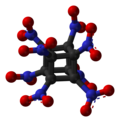| |||
| Names | |||
|---|---|---|---|
| Preferred IUPAC name Octanitrocubane | |||
| Identifiers | |||
3D model (JSmol) | |||
| ChemSpider | |||
PubChem CID | |||
CompTox Dashboard (EPA) | |||
| |||
| |||
| Properties | |||
| C8N8O16 | |||
| Molar mass | 464.128 g·mol−1 | ||
| Appearance | White solid | ||
| Density | 1.979 g/cm3 | ||
| Melting point | 200 °C (392 °F; 473 K) (sublimes) | ||
| Solubility | Slightly soluble in hexane, soluble in ethanol | ||
| Hazards | |||
| Occupational safety and health (OHS/OSH): | |||
Main hazards | Explosive compound | ||
| Explosive data | |||
| Shock sensitivity | Low | ||
| Friction sensitivity | Low | ||
| Detonation velocity | 10,100 m/s | ||
| Related compounds | |||
Related compounds | Cubane Heptanitrocubane Octafluorocubane | ||
Except where otherwise noted, data are given for materials in their standard state (at 25 °C [77 °F], 100 kPa). | |||
Octanitrocubane (molecular formula: C8(NO2)8) is a proposed high explosive that, like TNT, is shock-insensitive (not readily detonated by shock). [1] The octanitrocubane molecule has the same chemical structure as cubane (C8H8) except that each of the eight hydrogen atoms is replaced by a nitro group (NO2). As of 1998, octanitrocubane had not been produced in quantities large enough to test its performance as an explosive. [2]
Contents
It is, however, not as powerful an explosive as once thought, as the high-density theoretical crystal structure has not been achieved. For this reason, heptanitrocubane, the slightly less nitrated form, is believed to have marginally better performance, despite having a worse oxygen balance.
Octanitrocubane is thought to have 20–25% greater performance than HMX (octogen). This increase in power is due to its highly expansive breakdown into CO2 and N2, as well as to the presence of strained chemical bonds in the molecule which have stored potential energy. In addition, it produces no water vapor upon combustion, making it less visible, and both the chemical itself and its decomposition products (nitrogen and carbon dioxide) are considered to be non-toxic.
Octanitrocubane was first synthesized by Philip Eaton (who was also the first to synthesize cubane in 1964) and Mao-Xi Zhang at the University of Chicago in 1999, with the structure proven by crystallographer Richard Gilardi of the United States Naval Research Laboratory. [3] [4]


